Enhancing an Analysis Method of Compound Flooding in Coastal Areas by Linking Flow Simulation Models of Coasts and Watershed
Abstract
1. Introduction
2. Materials and Methods
2.1. Research Area
2.2. Characteristics of Watershed and Storm Sewer Networks
2.3. Models for Analyses
2.3.1. ADCSWAN (ADCIRC+SWAN) Model
2.3.2. FLOW-3D Model
2.3.3. XP-SWMM
2.3.4. Connections Among the Models
3. Results
3.1. Estimation of the Wave Overtopping Rate
3.2. Rainfall–Runoff and the 2D Simulation Model By XP-SWMM
3.3. Results of Inundation Simulation
4. Discussion
5. Conclusions
Author Contributions
Funding
Acknowledgments
Conflicts of Interest
References
- Song, Y.S.; Joo, J.G.; Lee, J.H.; Park, M.J. A study on estimation of inundation area in coastal urban area applying wave overtopping. J. Korean Soc. Hazard Mitig. 2017, 17, 501–510. [Google Scholar] [CrossRef]
- Kang, T.U.; Lee, S.H.; Sun, D.K. A technical review for reducing inundation damage to high-rise and underground-linked complex buildings in coastal areas (1): Proposal for analytical method. J. Korean Soc. Hazard Mitig. 2019, 19, 35–43. [Google Scholar] [CrossRef]
- Kim, J.S.; Lee, W.H. Analysis on complex disaster information contents for building disaster map of coastal cities. J. Korean Assoc. Geogr. Inf. Stud. 2016, 19, 43–60. [Google Scholar] [CrossRef]
- Vousdoukas, M.; Mentaschi, L.; Voukouvalas, E.; Kakoulaki, G.; De Souza Perreira, P.; Lino, A.; Feyen, L. Assessing compound flooding risk through dynamic simulations: Application in Recife, Brazil. In Proceedings of the 20th EGU General Assembly Conference, Vienna, Austria, 4–13 April 2018; Volume 20, p. 2589. [Google Scholar]
- Bevacqua, E.; Maraun, D.; Vousdoukas, M.I.; Voukouvalas, E.; Vrac, M.; Mentaschi, L.; Widmann, M. Higher probability of compound flooding from precipitation and storm surge in Europe under anthropogenic climate change. Sci. Adv. 2019, 5, eaaw5531. [Google Scholar] [CrossRef]
- Yook, K.Y.; Jung, J.H.; Shin, C.O.; Ahn, Y.S.; Lee, A.R. Evaluation and improvement of coastal areas’ climate change response capabilities: With focus on climate change adaptation capability of coastal municipalities. Korea Marit. Inst. 2012, 178–180. [Google Scholar]
- Kim, S.G. Busan City to Prepare Measures for Damage from Heavy Rain on July 7th. Available online: https://www.busan.go.kr/nbtnews/163377?curPage=1871&srchBeginDt=&srchEndDt=&srchKey=&srchText (accessed on 5 February 2020).
- Ye, F.; Zhang, Y.J.; Yu, H.; Sun, W.; Moghimi, S.; Myers, E.; Martins, K. Simulating storm surge and compound flooding events with a creek-to-ocean model: Importance of baroclinic effects. Ocean Model. 2020, 145, 101526. [Google Scholar] [CrossRef]
- Pokharel, P.; Takeda, M.; Matsuo, N. Study of inundation in the coastal city due to heavy rainfall considering the effect of global warming. In Proceedings of the World Environmental and Water Resources Congress 2007: Restoring Our Natural Habitat, Tampa, FL, USA, 15–19 May 2007; pp. 1–9. [Google Scholar]
- Ray, T.; Stepinski, E.; Sebastian, A.; Bedient, P.B. Dynamic modeling of storm surge and inland flooding in a Texas coastal floodplain. J. Hydraul. Eng. 2011, 137, 103–110. [Google Scholar] [CrossRef]
- Karamouz, M.; Zahmatkesh, Z.; Goharian, E.; Nazif, S. Combined impact of inland and coastal floods: Mapping knowledge base for development of planning strategies. J. Water Resour. Plan. Manag. 2015, 141, 04014098. [Google Scholar] [CrossRef]
- Choi, J.W.; Jun, H.D. Inundation Damage Assessment for Coastal Urban Area Considering Complex Causes of Inundation. J. Korean Soc. Hazard Mitig. 2018, 18, 283–290. [Google Scholar] [CrossRef][Green Version]
- Leroy, S.; Pedreros, R.; Andre, C.; Paris, F.; Lecacheux, S.; Marche, F.; Vinchon, C. Coastal flooding of urban areas by overtopping: Dynamic modelling application to the Johanna storm (2008) in Gâvres (France). Nat. Hazard Earth Syst. Sci. Discuss. 2014, 2, 4947–4985. [Google Scholar] [CrossRef]
- Gallien, T.W. Validated coastal flood modeling at Imperial Beach, California: Comparing total water level, empirical and numerical overtopping methodologies. J. Coast. Eng. 2016, 111, 95–104. [Google Scholar] [CrossRef]
- Suh, S.W.; Kim, H.J. Simulation of Wave Overtopping and Inundation over a Dike Caused by Typhoon Chaba at Marine City, Busan, Korea. J. Coast. Res. 2018, 85, 711–715. [Google Scholar] [CrossRef]
- O’Grady, J.G.; Cohen, R.C.; Prakash, M.; McInnes, K.L.; Hoeke, R.K. Wave overtopping in the city scale coupled hydrodynamic/hydraulic numerical inundation model: C-FAST. In Proceedings of the Australasian Coasts and Ports 2019 Conference: Future Directions from 40 [degrees] S and beyond, Hobart, Australia, 10–13 September 2019; pp. 924–927. [Google Scholar]
- Owen, M.W. Design of Seawalls Allowing for Wave Overtopping; Report No. Ex 924; Hydraulic Research: Wallingford, UK, 1980. [Google Scholar]
- Chen, X.; Ji, P.; Wu, Y.; Zhao, L. Coupling simulation of overland flooding and underground network drainage in a coastal nuclear power plant. Nucl. Eng. Des. 2017, 325, 129–134. [Google Scholar] [CrossRef]
- Ferreira, C.M.; Irish, J.L.; Olivera, F. Quantifying the potential impact of land cover changes due to sea-level rise on storm surge on lower Texas coast bays. Coast Eng. 2014, 94, 102. [Google Scholar] [CrossRef]
- Ferreira, C.M.; Irish, J.L.; Olivera, F. Uncertainty in hurricane surge simulation due to land cover specification. J. Geophys. Res. Ocean. 2014, 119, 1812–1827. [Google Scholar] [CrossRef]
- Bunya, S.; Dietrich, J.C.; Westerink, J.J.; Ebersole, B.A.; Smith, J.M.; Atkinson, J.H. A high resolution coupled riverine flow, tide, wind, wind wave and storm surge model for southern Louisiana and Mississippi: Part II—Synoptic description and analyses of Hurricanes Katrina and Rita. Mon. Weather Rev. 2010, 138, 378–404. [Google Scholar] [CrossRef]
- Dietrich, J.C.; Zijlema, M.; Westerink, J.J.; Holthuijsen, L.H.; Dawson, C.; Luettich, R.A.; Jensen, R.E.; Smith, J.M.; Stelling, G.S.; Stone, G.W. Modeling hurricane waves and storm surge using integrally-coupled scalable computations. Coast Eng. 2011, 58, 45–65. [Google Scholar] [CrossRef]
- Suh, S.W.; Lee, H.Y.; Kim, H.J.; Fleming, J.G. An efficient early warning system for typhoon storm surge based on time-varying advisories by coupled ADCIRC and SWAN. Ocean Dyn. 2015, 65, 617–646. [Google Scholar] [CrossRef]
- Xie, D.M.; Zou, Q.P.; Cannon, J.W. Application of SWAN + ADCIRC to tide-surge and wave simulation ingulf of maine during patriot’s day storm. Water Sci. Eng. 2016, 9, 33–41. [Google Scholar] [CrossRef]
- Deb, M.; Ferreira, C.M. Simulation of cyclone-induced storm surges in the low-lying delta of Bangladesh using coupled hydrodynamic and wave model (SWAN + ADCIRC). J. Flood Risk Manag. 2018, 11, 750–765. [Google Scholar] [CrossRef]
- Luettich, R.A.; Westerink, J.J. Formulation and Numerical Implementation of the 2D/3D ADCIRC Finite Element Model Version 44.XX; Theory report; University of North Carolina at Chapel Hill: North Carolina, NC, USA, 2004. [Google Scholar]
- Ziilema, M. Computation of wind-wave spectra in coastal waters with SWAN on unstructured grids. Coast. Eng. 2010, 57, 267–277. [Google Scholar] [CrossRef]
- Booij, N.; Ris, R.C.; Holthuijsen, L.H. A third-generation wave model for coastal regions: 1. Model description and validation. J. Geophys. Res. 1999, 104, 7649–7666. [Google Scholar] [CrossRef]
- Dentale, F.; Donnarumma, G.; Carratelli, E.P. Wave run up and reflection on tridimensional virtual breakwater. J. Hydrogeol. Hydrol. Eng. 2012, 1, 102–110. [Google Scholar] [CrossRef]
- Yakhot, V.; Orszag, S.A.; Thangam, S.; Gatski, T.B.; Speziale, C.G. Development of Turbulence Models for Shear Flows by a Double Expansion Technique. Phys. Fluids A Fluid Dyn. 1992, 4, 1510–1520. [Google Scholar] [CrossRef]
- Musa, M.A.; Maliki, A.Y.; Ahmad, M.F.; Sani, W.N.; Yaakob, O.; Samo, K. Numerical Simulation of Wave Flow Over the Overtopping Breakwater for Energy Conversion (OBREC) Device. Procedia Eng. 2017, 194, 166–173. [Google Scholar] [CrossRef]
- Kim, G.B. Numerical Simulation of Three-Dimensional Tsunami Generation by Subaerial Landslides. Ph.D. Thesis, Texas A&M University, Texas, TX, USA, 2012. [Google Scholar]
- Sogut, D.V.; Yalciner, A.C. Performance Comparison of NAMI DANCE and FLOW-3D® Models in Tsunami Propagation, Inundation and Currents using NTHMP Benchmark Problems. Pure Appl. Geophys. 2018, 176, 3115–3153. [Google Scholar] [CrossRef]
- Anees, M.T.; Abdullah, K.; Nordin, M.N.M.; Ab Rahman, N.N.N.; Syakir, M.I.; Kadir, M.O.A. One-and two-dimensional hydrological modelling and their uncertainties. Flood Risk Manag. 2017, 11, 221–244. [Google Scholar]
- Walch, M.P.; Christ, T.J.; Brant, W.M. Combining new Technologies with computer modeling to prevent sanitary sewer overflows resulting from urban rainfall induced peak flow conditions: The Miami–Dade Water and Sewer Department experience. In Proceedings of the ASCE 29th Annual Water Resources Planning and Management Conference, Tempe, AZ, USA, 6–9 June 1999; pp. 1–6. [Google Scholar]
- Phillips, B.C.; Yu, S.; Thompson, G.R.; De Silva, N. 1D and 2D modelling of urban drainage systems using XP-SWMM and TUFLOW. In Proceedings of the 10th International Conference on Urban Drainage, Copenhagen, Denmark, 21–26 August 2005; p. 68. [Google Scholar]
- Barnard, T.; Kuch, A.; Thompson, G.R.; Mudaliar, S.; Phillips, B.C. Evolution of an integrated 1D/2D modeling package for urban drainage. J. Water Manag. Model. 2007, 18, 343–365. [Google Scholar] [CrossRef]
- Ricks, M.D. Development of Computer Simulation Model for Urban Region Using XP-SWMM in Savannah, Georgia. Ph.D. Thesis, University of South Carolina, Columbia, CA, USA, 2015. [Google Scholar]
- Kang, N.R.; Kim, S.J.; Kim, Y.S.; Noh, H.S.; Hong, S.J.; Kim, H.S. Urban drainage system improvement for climate change adaptation. Water 2016, 8, 268. [Google Scholar] [CrossRef]
- Diya, S.G.; Kamarudin, M.K.A.; Gasim, M.B.; Toriman, M.E.; Juahir, H.; Umar, R.; Saudi, A.S.M.; Abdullahi, M.G.; Rabiu, A.A. Flood simulation model using XP-SWMM along Terengganu River, Malaysia. J. Fundam. Appl. Sci. 2017, 9, 66–81. [Google Scholar] [CrossRef][Green Version]
- Hasan, H.H.; Razali, M.; Fatin, S.; Zaki, A.; Ibrahim, A.Z.; Mohamad Hamzah, F. Integrated hydrological-hydraulic model for flood simulation in tropical urban catchment. Sustainability 2019, 11, 6700. [Google Scholar] [CrossRef]
- Lee, H.Y.; Suh, S.W. Application of EurOtop to improve simulations of coastal inundations due to wave overtopping. J. Coast. Res. 2016, 75, 1377–1381. [Google Scholar] [CrossRef]
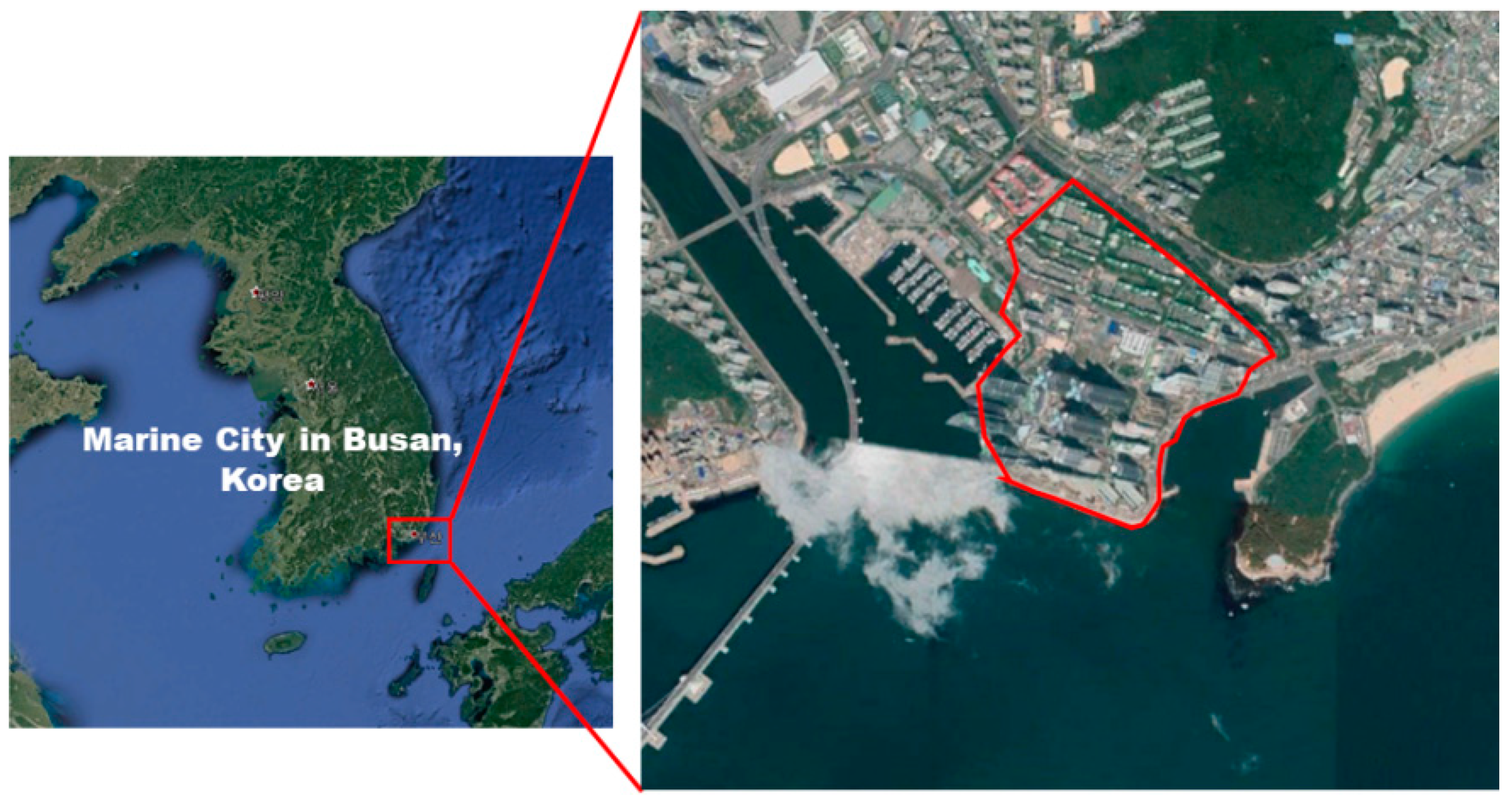
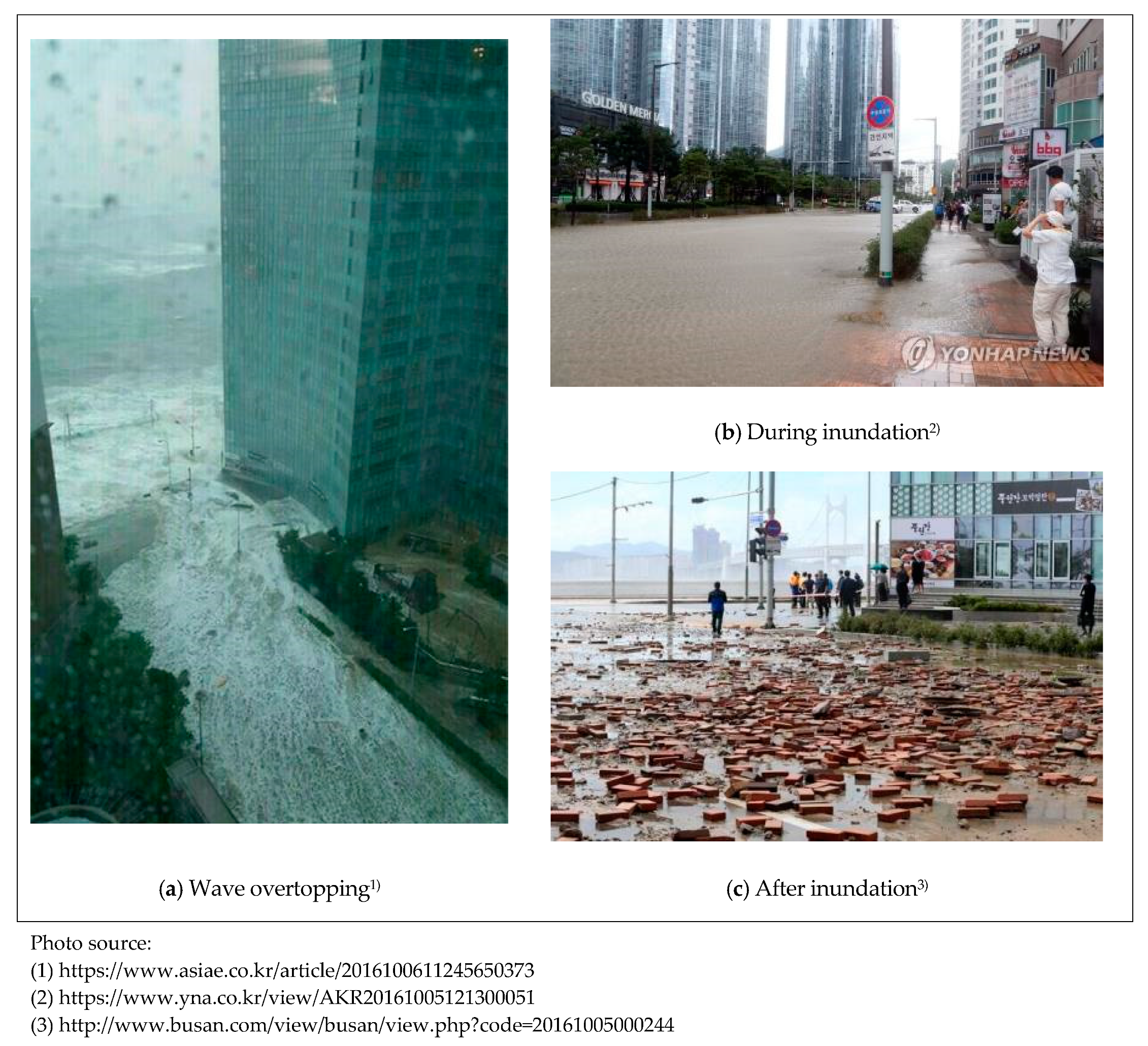


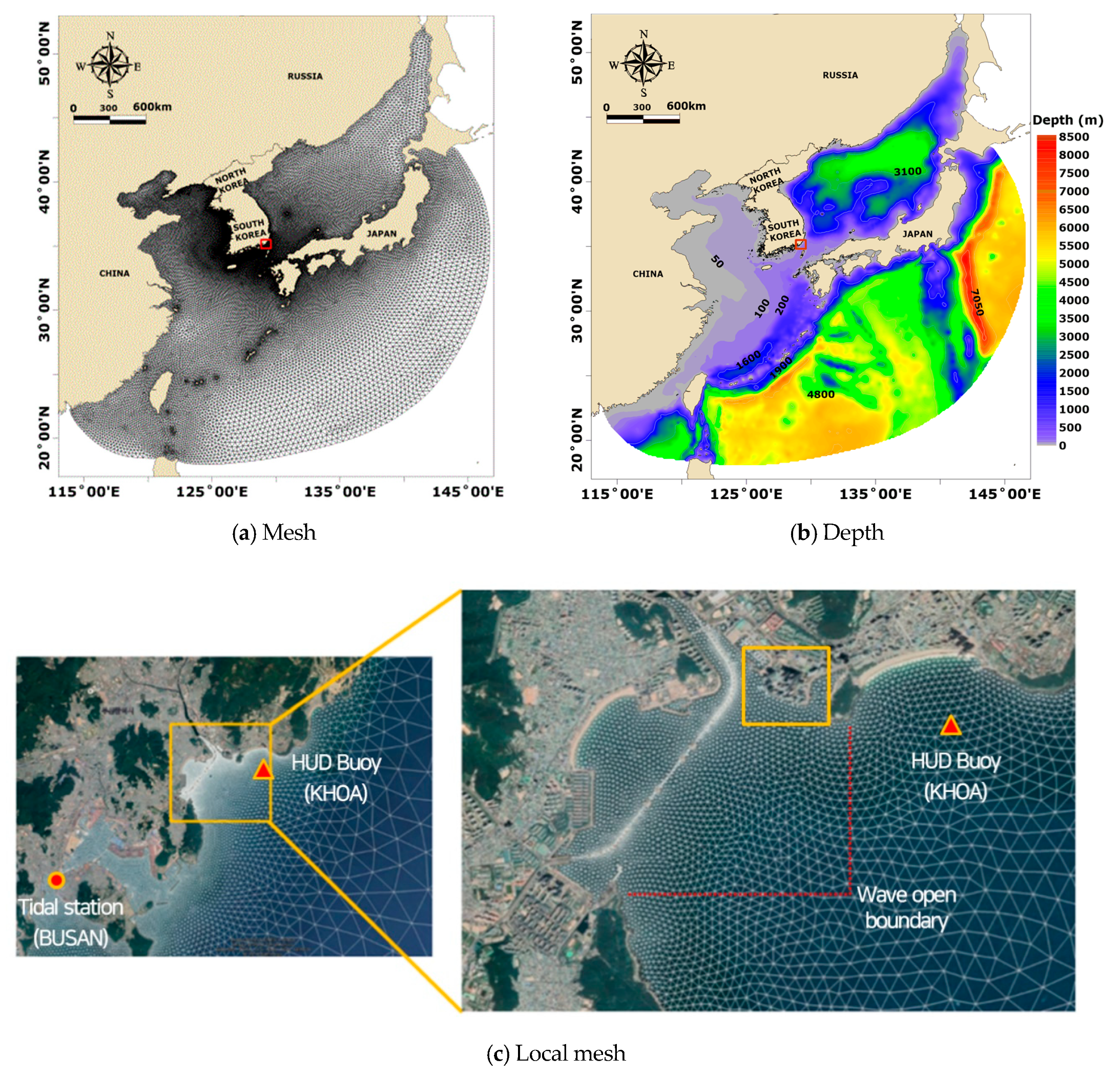
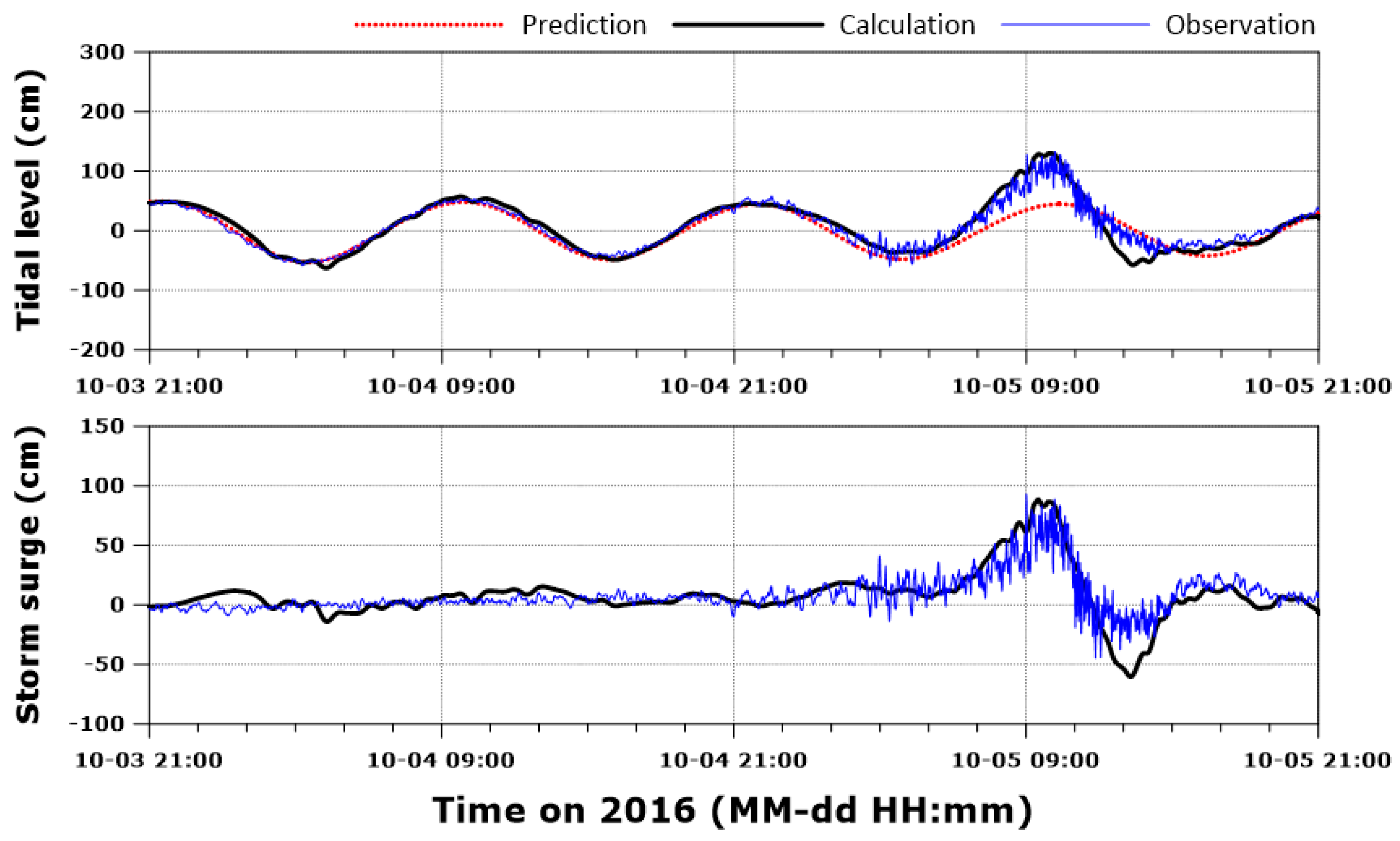


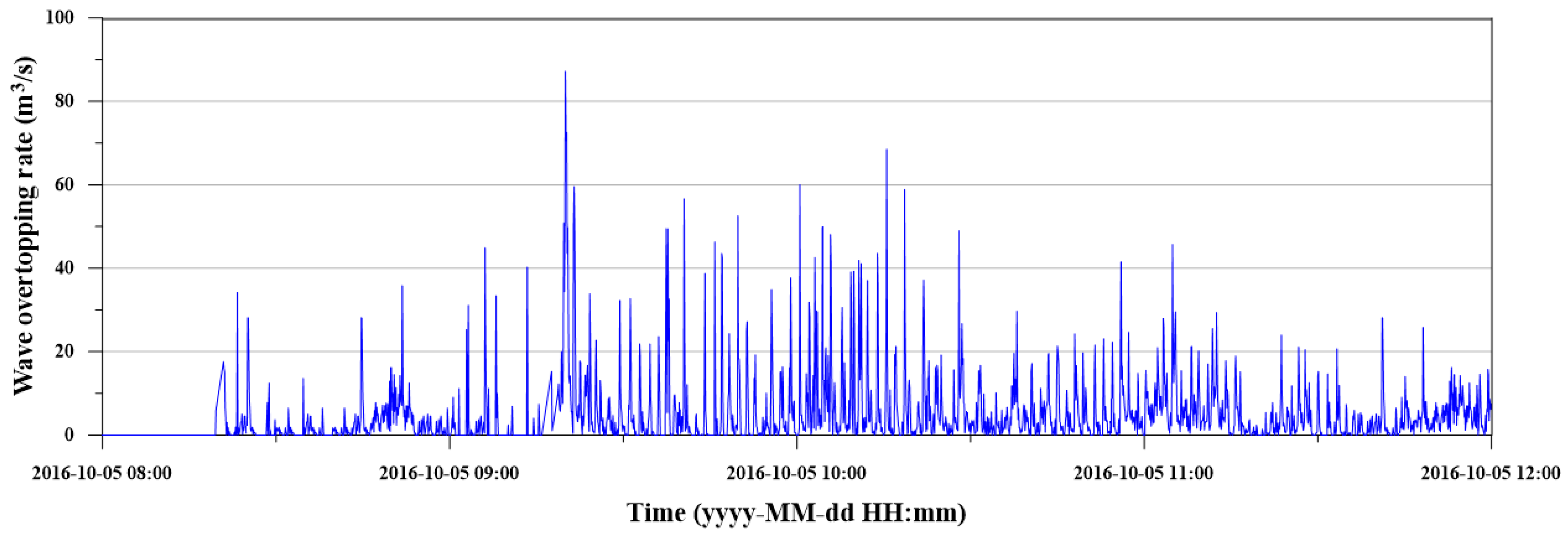
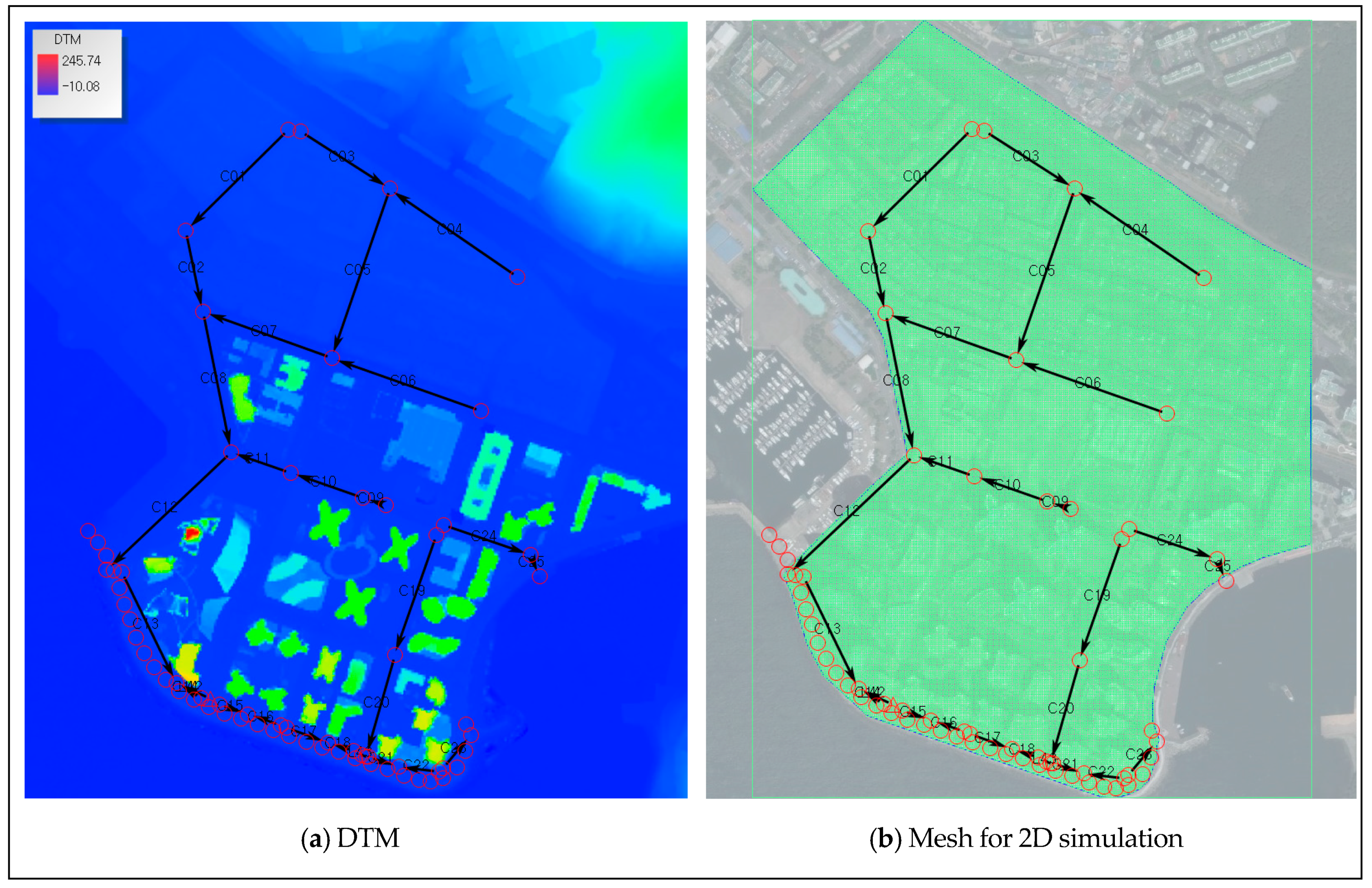
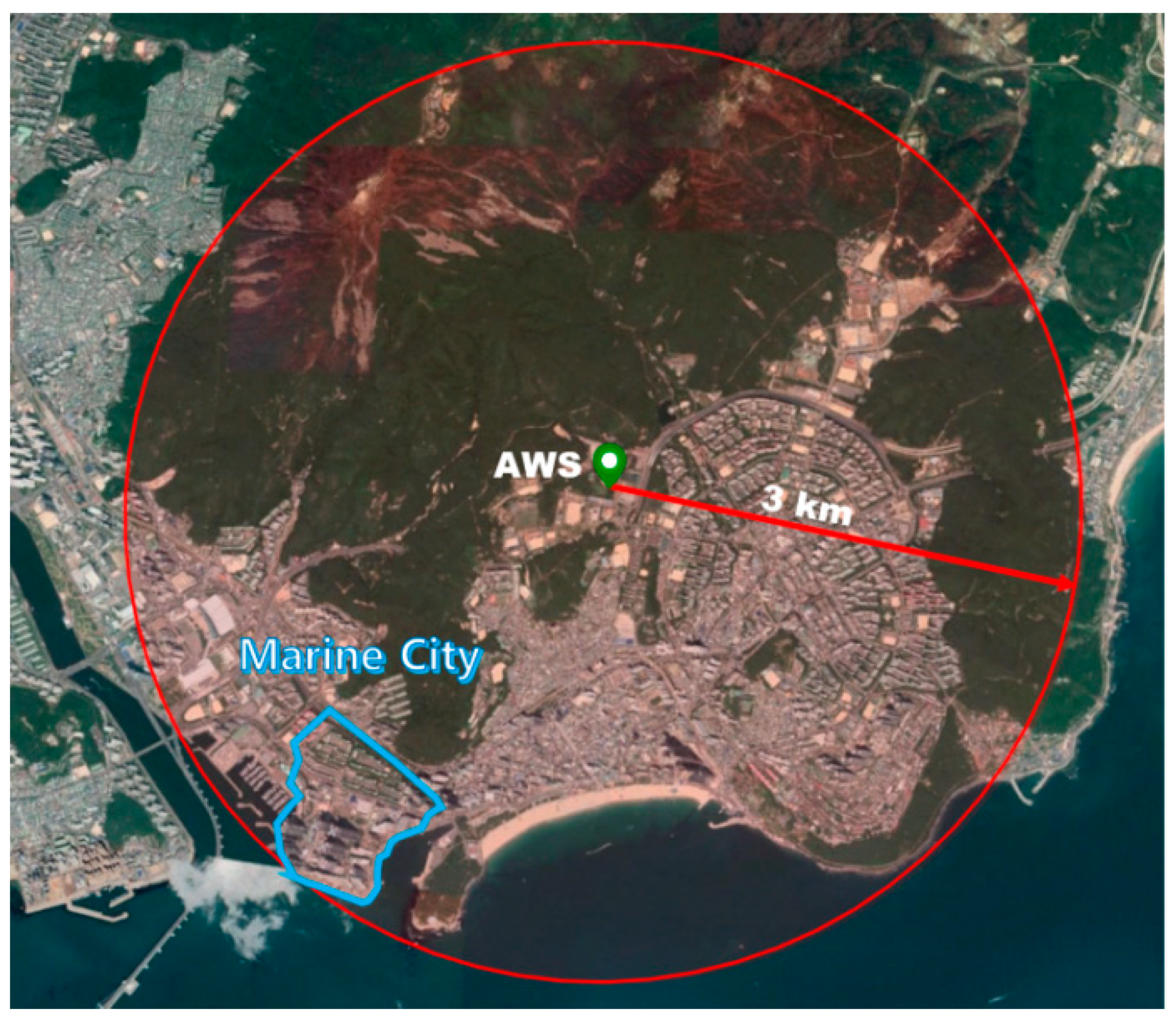
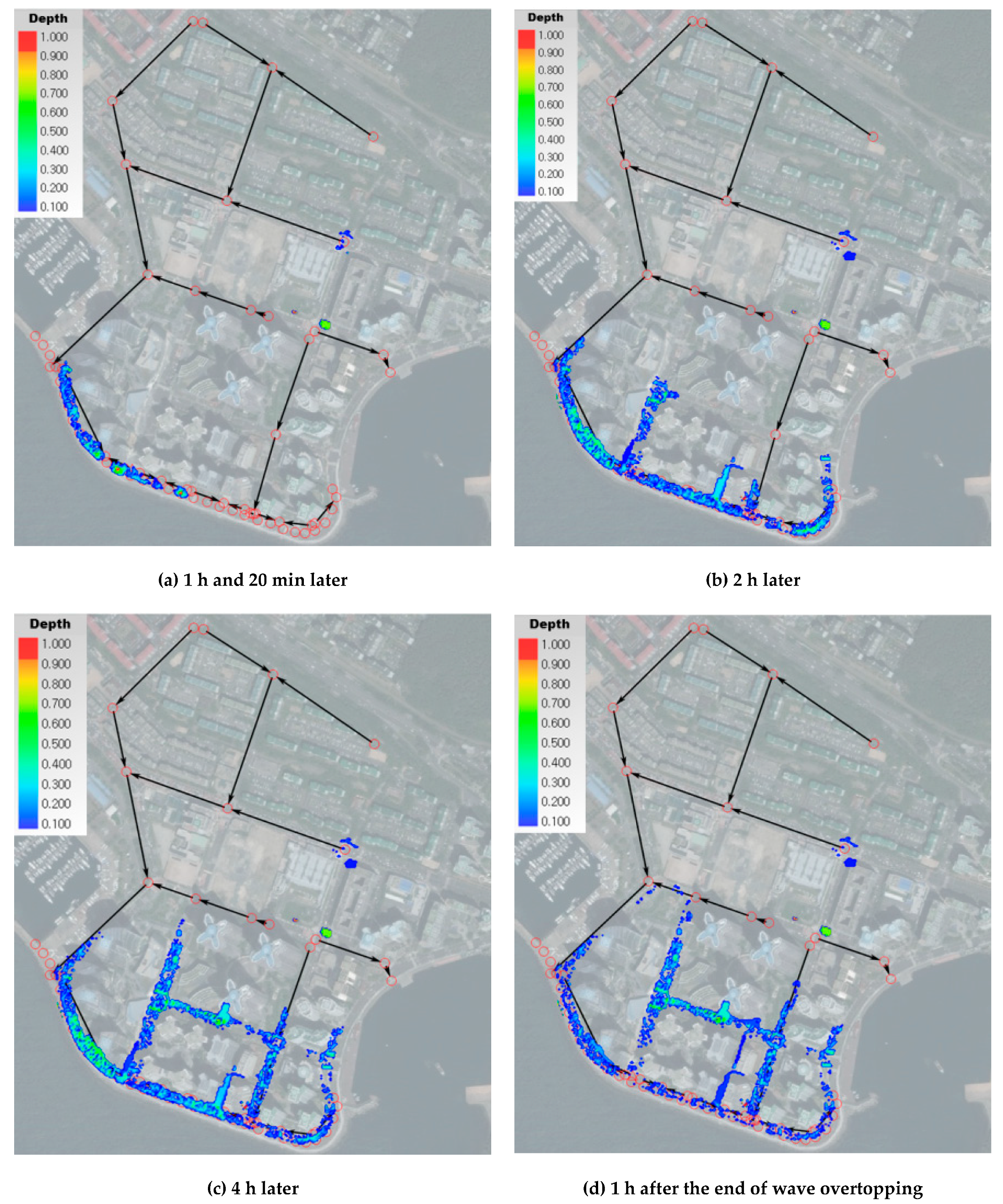
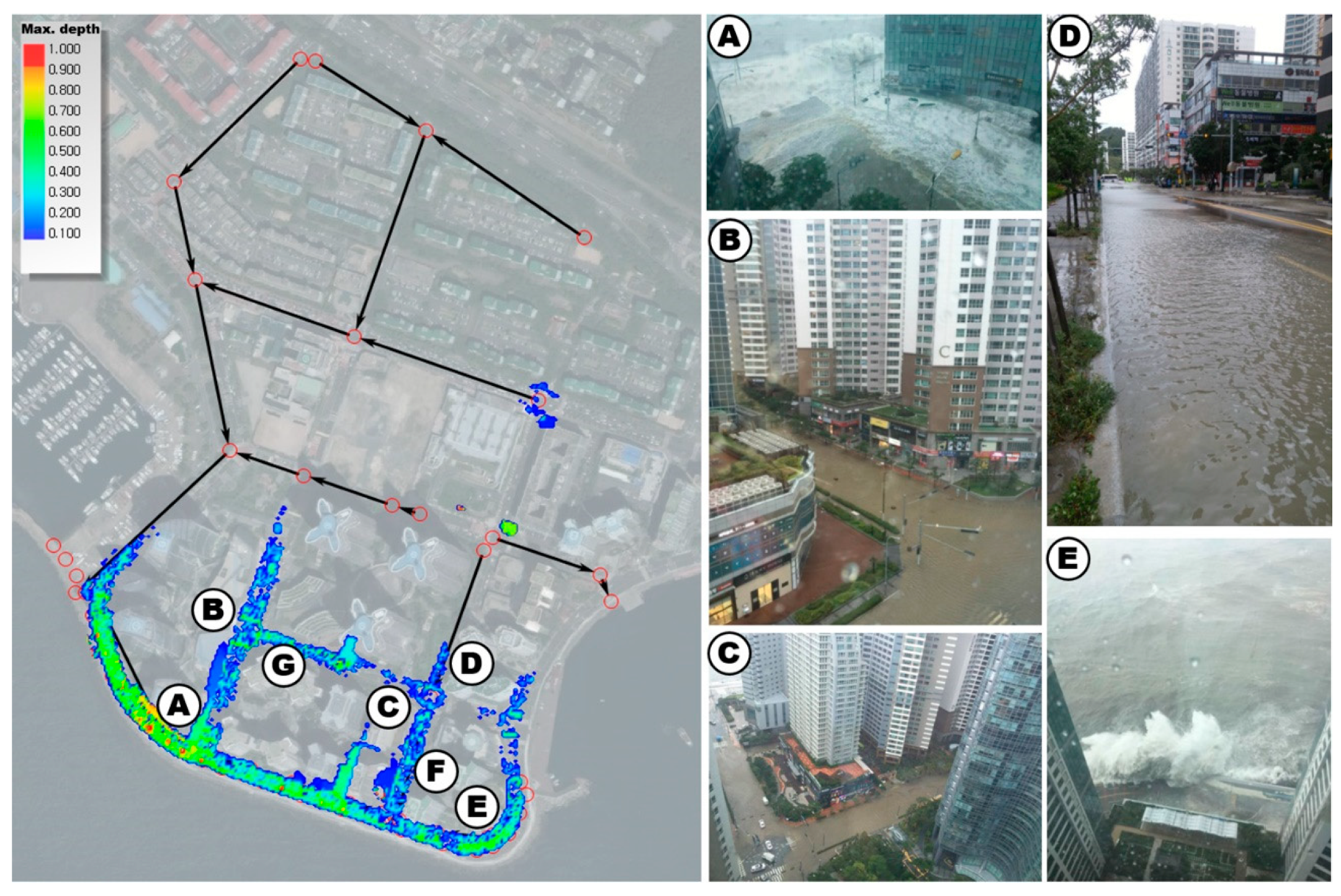



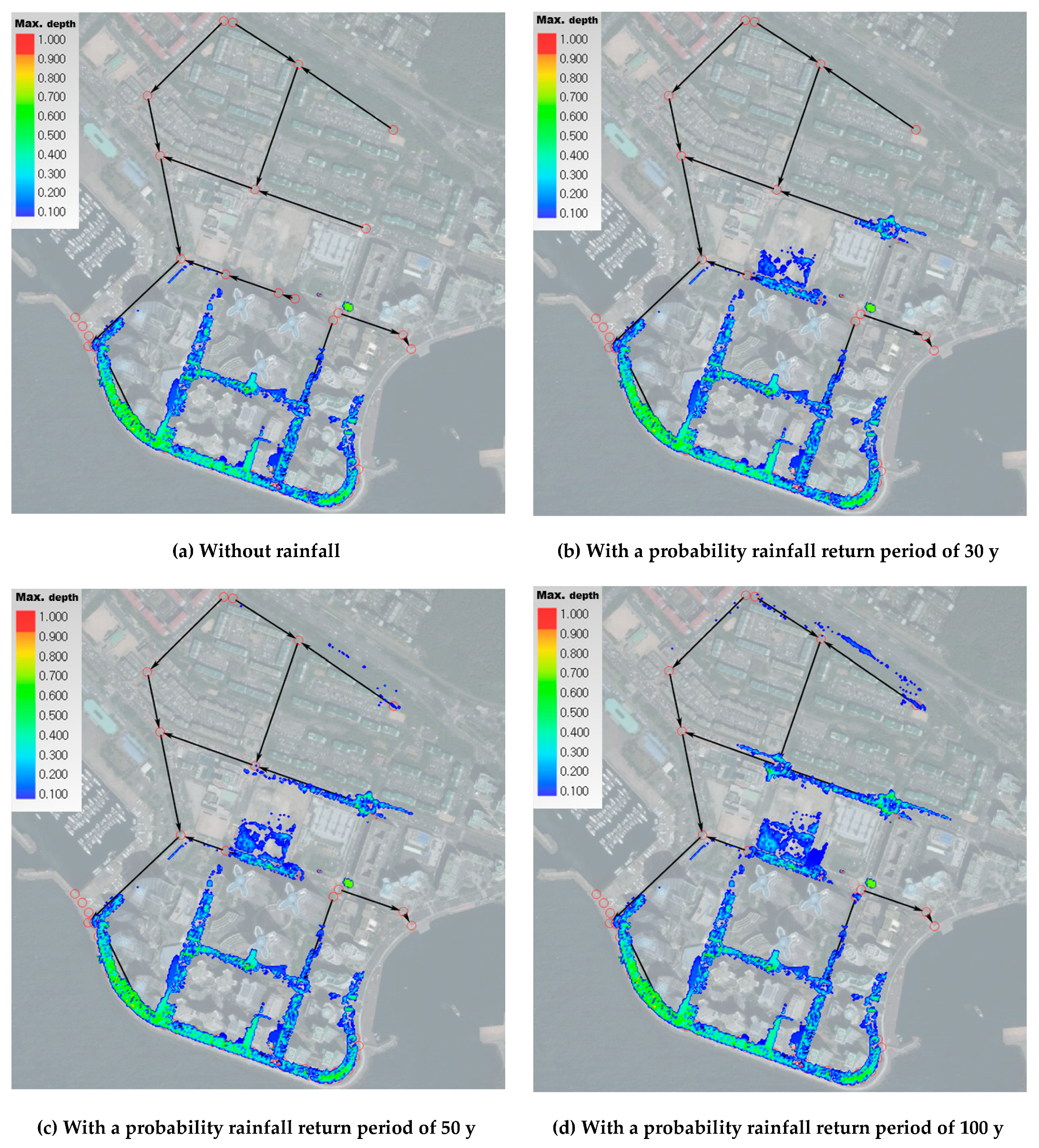
| Classification | Information and Options | |
|---|---|---|
| Model versions | ADCIRC-Ver. 50.99 and SWAN-Ver. 40.41 | |
| Calculation parameters | Drag coefficient: max = 0.003 Reduction coefficient: reduction rate for sea surface wind = 0.7 | |
| External force | Atmospheric pressure and wind: KMA (Korea Meteorological Administration) typhoon best track information Sea surface wind: Holland gradient wind vortex algorithm | |
| Composition for model | Time step | ADCIRC: 3 sec; SWAN: 5 min |
| Domain | 18°N∼52°N, 114°E∼148°E | |
| Grid resolution | Maximum: 30 km; minimum: 30 m (triangle unstructured grid) | |
| Grid | Element: 183,709; node: 99,011 | |
| Depth data | KHOA (Korea Hydrographic and Oceanographic Agency) and GEBCO (General Bathymetric Chart of the Oceans) | |
| Classification | Information and Options | ||
|---|---|---|---|
| Watershed and drainage system | Watershed area (km2) | 0.53 | |
| Number of subcatchments | 25 | ||
| Number of conduits | 25 | ||
| Number of outfalls | 8 | ||
| Rainfall station | Name | Haeundae automatic weather system | |
| Time interval | 5 min | ||
| Simulation method | Watershed routing | Nonlinear storage equation | |
| Channel routing | Dynamic wave model | ||
| Infiltration method | Horton equation | ||
| Calculation time step | Watershed | 5 min | |
| Channel | 10 s | ||
| Location in Figure 13 | Measurement (m) | Simulation (m) | Error (m) | Accuracy (%) |
|---|---|---|---|---|
| Ⓐ | 0.80 | 0.72 | 0.09 | 88.8 |
| Ⓕ | 0.50 | 0.46 | 0.04 | 92.0 |
| Ⓖ | 0.50 | 0.44 | 0.05 | 88.0 |
© 2020 by the authors. Licensee MDPI, Basel, Switzerland. This article is an open access article distributed under the terms and conditions of the Creative Commons Attribution (CC BY) license (http://creativecommons.org/licenses/by/4.0/).
Share and Cite
Lee, S.; Kang, T.; Sun, D.; Park, J.-J. Enhancing an Analysis Method of Compound Flooding in Coastal Areas by Linking Flow Simulation Models of Coasts and Watershed. Sustainability 2020, 12, 6572. https://doi.org/10.3390/su12166572
Lee S, Kang T, Sun D, Park J-J. Enhancing an Analysis Method of Compound Flooding in Coastal Areas by Linking Flow Simulation Models of Coasts and Watershed. Sustainability. 2020; 12(16):6572. https://doi.org/10.3390/su12166572
Chicago/Turabian StyleLee, Sangho, Taeuk Kang, Dongkyun Sun, and Jong-Jip Park. 2020. "Enhancing an Analysis Method of Compound Flooding in Coastal Areas by Linking Flow Simulation Models of Coasts and Watershed" Sustainability 12, no. 16: 6572. https://doi.org/10.3390/su12166572
APA StyleLee, S., Kang, T., Sun, D., & Park, J.-J. (2020). Enhancing an Analysis Method of Compound Flooding in Coastal Areas by Linking Flow Simulation Models of Coasts and Watershed. Sustainability, 12(16), 6572. https://doi.org/10.3390/su12166572





